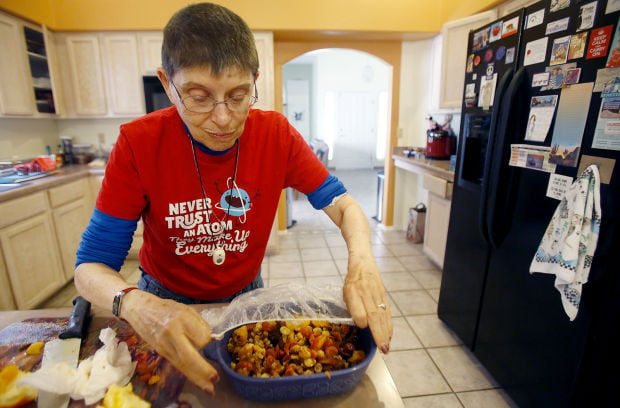For Deena Sortland, making charoset for the Passover Seder plate brings sweetness to her own life.
The paste-like mixture of fruit, nuts and wine is part of the symbolic Seder meal that takes place on the first two nights of the holiday for Jews outside of Israel. Passover begins Friday at sundown.
Charoset represents the mortar the enslaved Israelites used to make bricks in ancient Egypt, but it also reminds Sortland, 77, of her own family’s survival of the Holocaust and her rediscovery of Jewish traditions as an adult.
Although the basic ingredients of charoset remain consistent, the dish leaves room for creativity and regional variations that reflect the diversity of Jewish communities, said Rabbi Yehuda Ceitlin, outreach director for Chabad Tucson, 2443 E. Fourth St. Even Ben & Jerry’s took a crack at it, with charoset-flavored ice cream sold in Israel this year.
“Each community added in from their own culture and taste, giving it the more local flavor, but all meaning the same thing,” Ceitlin said, adding that he has not yet found a Tucson store that sells charoset.
Sortland’s roots are in the Ashkenazic Jewish community of Central and Eastern Europe. She was born in Brussels, Belgium, in 1937, and her family fled the Holocaust in 1940. It took them more than a year to make it to the United States, she said.
Her parents quickly assimilated into American culture, and Sortland only remembers one Passover Seder from her childhood. Not long after arriving in the U.S., the family was invited to celebrate the holiday in someone’s home.
“I just loved it, and my parents didn’t pick up on it, so the next Seder I celebrated, I was married and in my own home,” she said. “I needed to rebuild all these bridges that got destroyed because of the war.”
When she started celebrating Passover as an adult, she found she disliked the nuts in traditional Ashkenazic recipes, which also uses apples, honey and sweet wine.
About 20 years ago, she adopted a charoset recipe that she said draws on Sephardic traditions from the Iberian Peninsula and uses apricots, dates and oranges.
Sortland attends Congregation Kol Simchah, which meets at St. Francis in the Foothills United Methodist Church, 4625 E. River Road. Her return to her Jewish heritage is like the common Passover practice of dipping bitter herbs in charoset.
“It’s an ongoing process,” she said of this rediscovery. “It has been sweet and bitter because of everything that happened. I could have died in the Holocaust very easily, but I didn’t, so I want to recreate my traditions.”
Hava Shahar’s family also came through the Holocaust. Her parents, born in Eastern Europe several years before the start of World War II, met each other in Israel.
Shahar grew up celebrating Passover in her hometown of Holon, Israel, and makes an Israeli version of charoset with Eastern European influences that reflect her family’s background.
“This is what I grew up with,” Shahar, 52 said, though she has experimented as she has encountered other traditions. She moved to the United States in 1990 and is now a member at Chabad Tucson.
“Most people will have the basic nuts, apples, and then everyone adds to that a little wine,” Ceitlin said. This is a recipe common to many North American Jews with Ashkenazic backgrounds. Regional influences may include ginger, cinnamon, dates, raisins, matzo meal and a variety of nuts and fruits.
Sandra Birnbaum, a member at Temple Emanu-El, 225 N. Country Club Road, swaps her home in Toronto, Canada, for winters in Tucson. Because of food allergies, her Sephardic style of charoset never uses walnuts. Birnbaum, 71, opts for almonds instead.
The dish represents freedom and hope even in moments of bitterness, and when it comes to charoset, Birnbaum believes that “simple is best.”
“Passover gives us a break from the daily grunt of work, the grunt of life,” Ceitlin said. Charoset is a reminder of that work. “Everyone must simply take a break from what they’re doing.”





